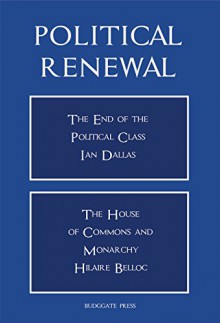Political Renewal: The End of the Political Class / The House of Commons and Monarchy
Political Renewal is a devestating historical survey of the relentless degeneration that has characterised the British political class and its social and constitutional apparatus over the last century or more. Two piercing essays, one by our Author, and the other by the French historian Hilaire...
show more
Political Renewal is a devestating historical survey of the relentless degeneration that has characterised the British political class and its social and constitutional apparatus over the last century or more. Two piercing essays, one by our Author, and the other by the French historian Hilaire Belloc, are juxtaposed in one volume.
During the French Revolution the transfer of monarchic power to assembly power veiled the realities of the social system. The concept that the society of orders gave way to the society of class does not fit either the former or the latter structure.
The former had been a power system. The nobility, the clergy, and the people.
The latter has always postured as a unitary class of citizens. This, however, does not delineate the role of wealth in the system. The nineteenth century saw the politically undefined model of bourgeois and proletarian. Assembly is then posited as a bourgeois entity devised to protect their ownership of the means of production. Means crudely meaning the industrial nexus, and production the wealth-producing object for sale.
The society of orders had as its intermediary body the clergy, interfacing with the aristocracy from whom they recruited their ruling elite of bishops and cardinals, and the masses whose births, deaths and marriages they supervised and whom as landowners they employed. Yet the matter does not rest there. The first major crisis in the monarchic system came from the emergence of the clergy’s gradual assumption of power. That power was finance. In the conflict two orders clashed – the clergy and the nobility.
The first opposition was political, already in its modern sense, that is government against King. As the struggle continued it became clear that at stake was the wealth, that is power, of France. In the second phase of La Fronde it was clear that the protagonists were church and nobility. The internationalist catholic church opposed the nationalist nobility. Richelieu versus Le Grand Condé. Richelieu had understood that wealth was the instrument of power. Mazarin consolidated this banking power for the King.
The end of the Fronde was the end of the nobility, not the Revolution. When Fouquet lost his palace, Vaux-Le-Vicomte, Louis built Versailles on his prototype. Colbert succeeded Mazarin and thus the King chose the money over his blood relatives.
The Revolution swept aside the Monarchy to get at the wealth. The real change was the abolition of the clergy as bankers of Monarchy which led to a power vacuum of wealth. It was into that post-Colbertian vacuum that there emerged a new order, called by Proudhon ‘Le Secte’, for they were sociologically a religious order in secular yet distinctive robes – the Bankers.
After the Revolution three new orders emerged.
1) The Banking elite, who were to evolve rapidly in an evolutionary growth that was assured by the Revolution. Napoleon created La Banque de France. Then came La Bourse, finally La Défence.
2) The political class. Now they found that their role was subservient to, and dependent on, the financial elite. They were the protective veil over wealth, hiding it from the people.
3) The masses – the Citizens – they were to live in the illusion that the political class only controlled social services, dependent on the masses’ taxation, not the corporate wealth of the elite.
This, the Democratic Order, is now set to collapse at the point the financial elite pursued their usurious system to its logical conclusion of an utterly reduced set of oligarchs controlling a world financial mathematic in turn reaching its logical mathematical point of collapse.
show less

